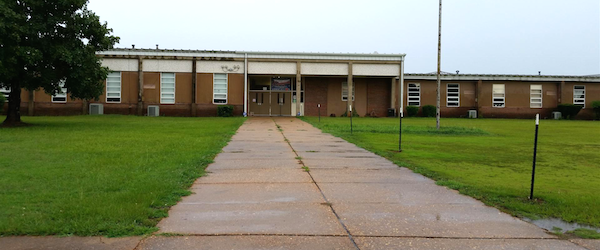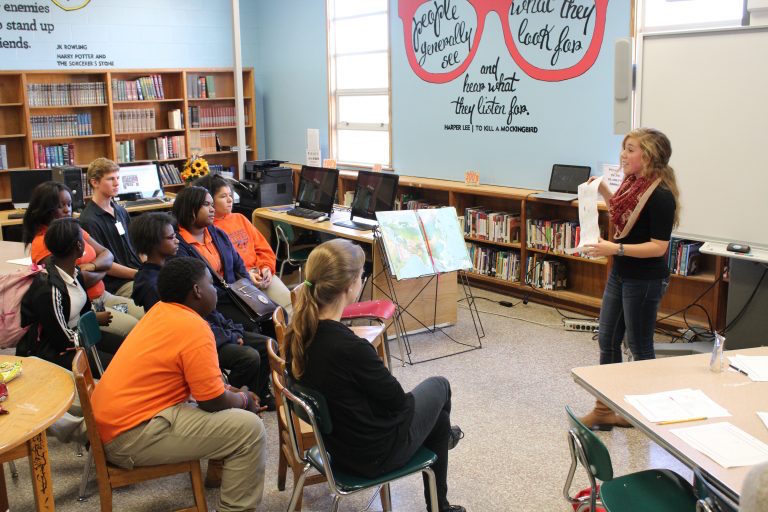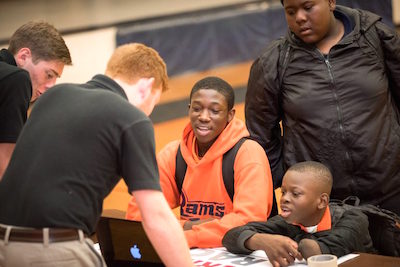In the fall of 2016, the staff of Francis Marion, a comprehensive PreK-12 school in rural Perry County, Alabama utilized one of our in-service days at the beginning of school to ride school buses. Our goal was to understand what our students experience before they arrive at school, including the distance and amount of time on the bus before the school day begins.
This “bus ride PD” proved to be grueling for the staff members (as it can be for our students). During one long bus trip, one of the high school teachers became ill and had to be transported to the hospital via ambulance.
This unhappy experience could have been even more anxiety-producing, as this teacher had left her personal items at school. Fortunately, we had just instituted a buddy system among our elementary and secondary staff, and her elementary Buddy Teacher went into action and came to her rescue.
The ill teacher’s husband could not be reached, but her Buddy Teacher notified our administrators of what was going on. She tended to her Buddy’s needs and although she was not allowed to ride in the ambulance to the hospital with her, she went back to the school to collect her Buddy Teacher’s personal items, immediately drove to the hospital, and remained with her colleague until her family arrived.
The difficult challenge of merging schools
It was a happy coincidence that the morning prior to this bus riding incident, I had assigned each faculty member with a Buddy Teacher and asked Buddy Teachers to ride together on the bus in an effort to foster communication, open up dialogue, and encourage teachers across our 14 grade levels to get to know each other better.
The idea of Buddy Teachers came to me after I observed and experienced the lack of unity among our PreK-12 staff. This may not be the case for all elementary-secondary combo schools but it was the case at Francis Marion, which became a comprehensive school just a few years ago. In 2015, due to declining enrollment and a chronic lack of resources, the district had to make an enormous financial decision that involved closing our elementary schools and merging them into our two high schools.

Although our merger at Francis Marion brought two faculty and staffs together physically, that was not the case mentally or socially. The merged staffs remained divided in staff meetings, social events, even celebrations such as Christmas parties which were for “us” and not “them.” Neither staff went out of their way to support the other staff members or their students.
Educationally, there was no collaboration or desire to collaborate even though vertical planning was expected, needed and scheduled. The cohesiveness we needed to make the school successful did not exist.
The new school structure consisted of three grade bands: PreK-3rd; 4th-6th; and 7th-12th. Each band had its own administrator. Initially, the school was organized in this format to make certain the age levels of the students did not intermingle, which could cause social problems. We also needed to make certain each grade grouping had an administrator to hear concerns and be there for them as needed.

Parents at each grade level knew exactly who to contact if needed, and the students in each grade band knew exactly who they would be interacting with on a daily basis. If teachers needed assistance, their administrator would be there. Fortunately, these goals were accomplished; however, each grade band stayed within its own cocoon and felt comfortable with “their” colleagues and administrator. It was “our world” and no other grades mattered.
The elementary teachers’ world involved vibrant colorful classrooms with themes and exciting bulletin boards that typically changed every month. Their lessons included students in centers actively engaged in a myriad of activities, in part due to grade level collaboration and their exchange of new and exciting ideas.
On the other hand, many secondary classroom teachers focused more on their teaching of content and gave little thought to dynamic classroom arrangements or bright bulletin boards. “That’s not going to be on the student’s high stakes assessment.”
The centers students experienced in elementary school typically were replaced by desks in rows in the high school, and the most actively engaged individual in the classroom was the teacher – either giving a lecture, reviewing for tests, or barking out assignments. There were two to three different cultures existing in one school.
Promoting collaboration across PreK-12
Needless to say, in the situation I describe, teacher morale was low and teacher turnover was high. After riding the waves of this chaotic, autonomous setting for a year, the Buddy Teacher system evolved. Elementary and secondary teachers were partnered together – as well as veterans and inexperienced teachers – to create a culture of support and unity.
The Buddy Teacher program involves:
- Sitting together in staff meetings for social and collaborative purposes;
- Assisting with iNow, our grading system and procedures;
- Answering new teachers’ questions and providing support for them as they start their new journey;
- Observing each other’s classroom to offer advice and suggestions;
- Observing each other’s classroom to learn different teaching methods and techniques;
- Assisting each other with the required use of technology in the 21st Century classroom.

The idea of partnering veteran teachers and inexperienced teachers was to provide support when needed. Also, many times new teachers may have questions they don’t feel comfortable asking out loud for fear they may be asking something “dumb.” The veteran teachers can answer those questions without making the novices feel uncomfortable or embarrassed.
Also, many new teachers need assistance with discipline and other first year issues. Our Buddy Teacher system has helped them to get advice and seek wisdom from those who have experience in the education field and at the school. Many times the veterans are able to share techniques that work with specific students.
It’s all about relationships
One of the greatest benefits of this school-wide collaborative effort has been the building of relationships. Relationships that span grade levels, disciplines, and age groups have flourished and made staff meetings and professional development days less heart wrenching and more engaging.
The math teachers who taught grades 3-12 planned our first Math Bowl Competition for these grades during one of their vertical team meetings. The elementary and high school English department teachers collaborated and wrote a short Christmas play that became a preK-12 production that was seen by the entire school and parents.
This year Francis Marion School was removed from Alabama’s failing school list, mainly because of the culture shift from individualism to collective and collaborative efforts — sharing data, planning together, and building positive relationships.

This culture change among the faculty has even affected our students as discipline referrals have decreased by over 40 percent, in part because all teachers are working together on the same progressive discipline plan. Students can no longer go in one class and expect one thing and go into another teacher’s class and expect something different. Everyone is on the same page.
As a result, our once divided staff has become more unified and continues to work together to improve student achievement. The elementary teachers visit the high school classrooms and help do those vibrant bulletin boards and inviting classroom arrangements. The secondary teachers visit the elementary classrooms to observe how centers are done and to share insights about the content and skills that students will need to know as they advance through the grades. The Buddy Teachers celebrate personal events and professional events in each other’s lives.
Although the teacher falling ill on the bus was an unfortunate incident, it was the boost that was needed to promote the idea of the Buddy Teacher system. The elementary buddy teacher was able to give updates on her high school buddy teacher’s condition. She provided support for her colleague which immediately allowed the other teachers to see how important such a relationship could be.
Happily, the high school teacher recovered from her malady, and our Francis Marion staff has recovered from its malady, divisiveness, too. Both are flourishing well.
Dr. Cathy Trimble is a Francis Marion High School graduate who came back to her school district initially as a substitute teacher. Eventually she was hired as a paraprofessional and then a Physical Education teacher at her alma mater. Determined to make a difference, Trimble later became assistant principal and finally principal. She has been instrumental in leading the school through a difficult school merger and getting it removed from Alabama’s failing school list.


0 Comments on "Buddy Teachers: Moving a PreK-12 School from Pessimism to Partnership"